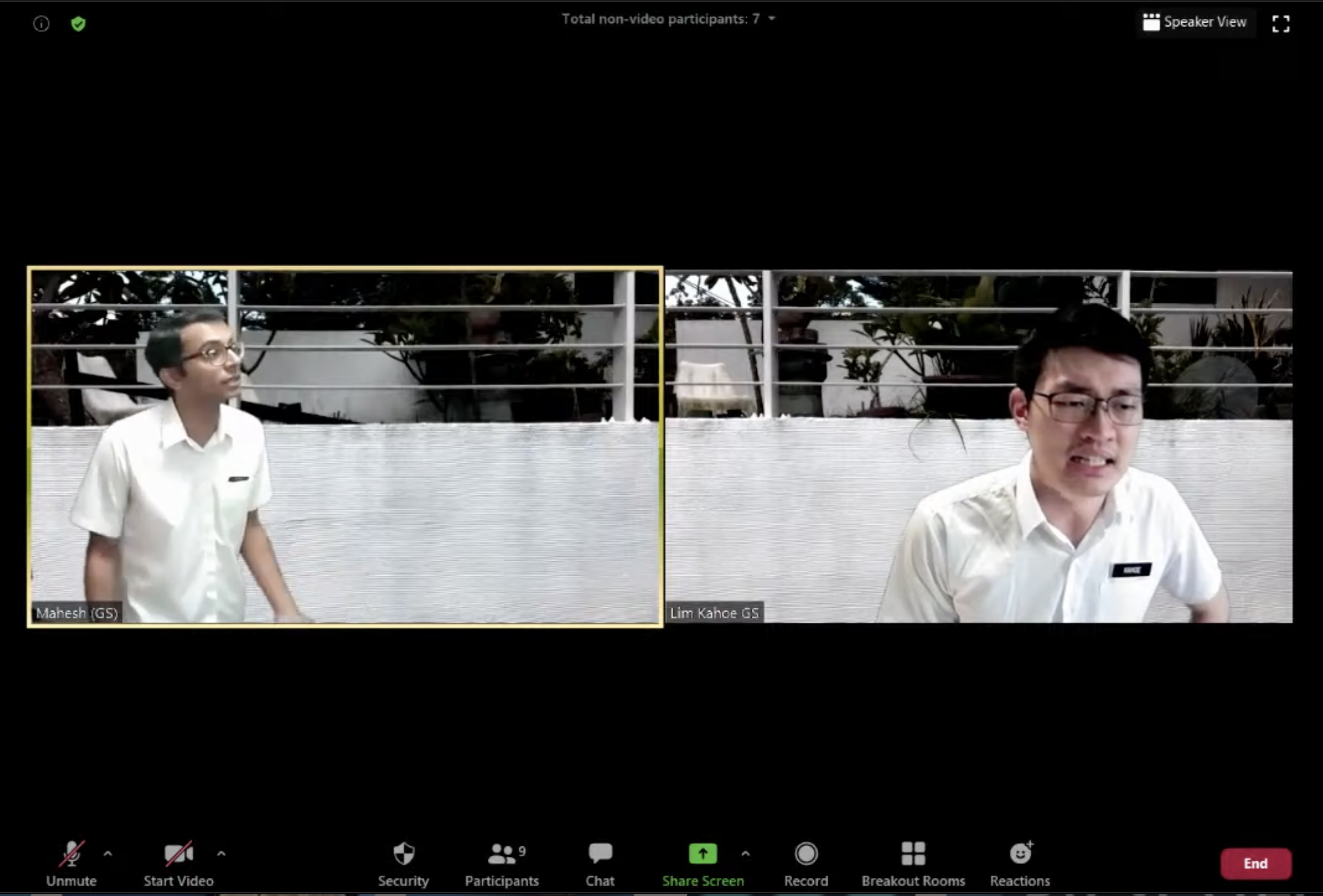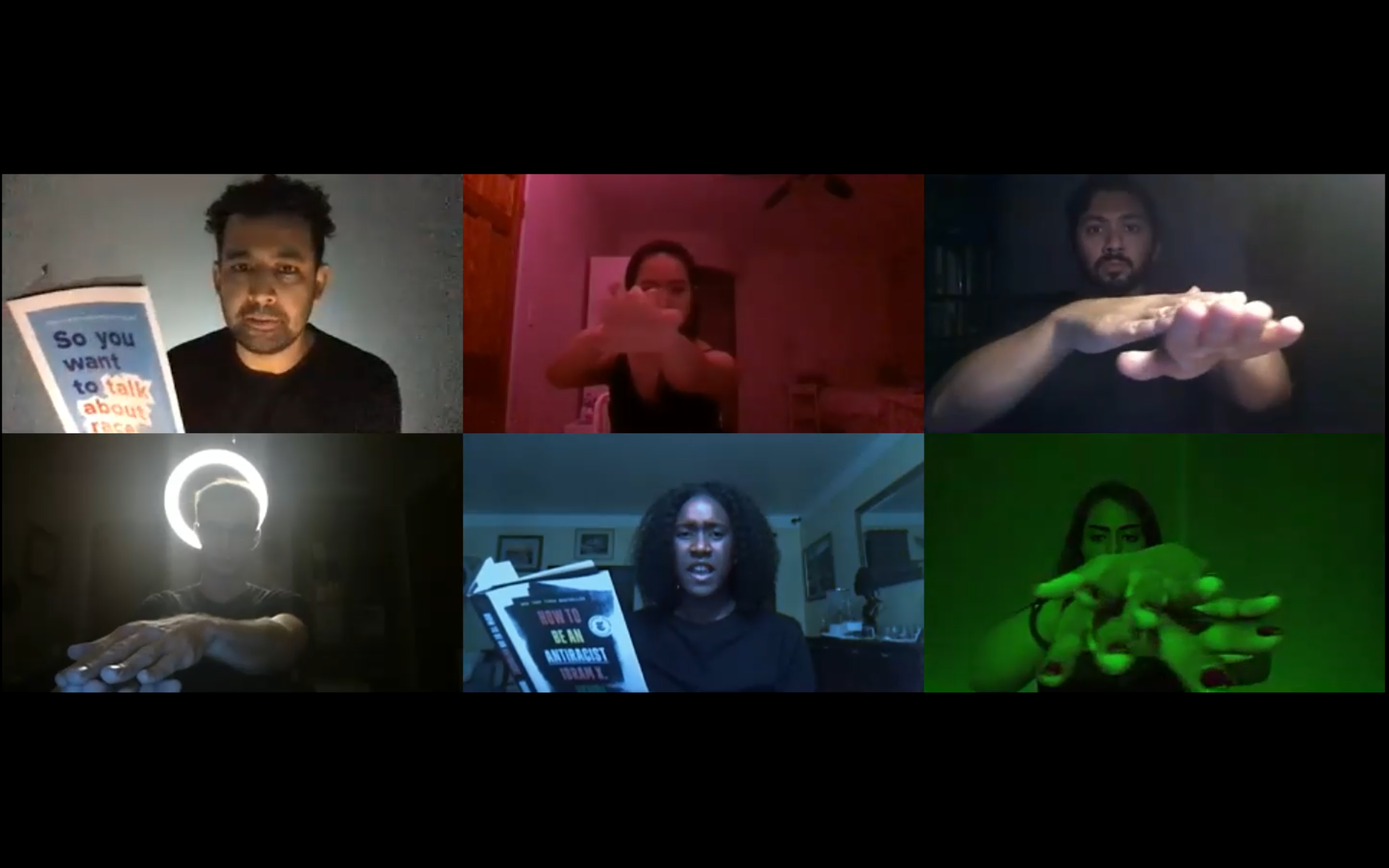In late July, sitting in my sister-in-law’s home in St. Louis, Missouri, I waited in the “lobby” area of Cloud Theatre for Zoom Parah to begin. Itself a creation born of the pandemic, Cloud Theatre is an online platform which strives to offer a seamless digital theatre experience to global audiences. Their “lobby” is a simple but smart artificial space: a live chat box, available to attendees as they login for a show, is positioned next to the image of a theatre stage, framed by red curtains. The waiting room attempts to replicate the experience of audience members mingling and chatting before a performance begins. Joining others in this virtual space, I was excited to see another Malaysian, also based in the United States, mention that they were from Petaling Jaya—my hometown. I excitedly typed back, “I’m from PJ, too!” The spark of recognition flashing across the chat box was akin to overhearing a conversation between strangers, and interjecting to share a mutual connection. Months into social distancing protocols, the Cloud Theatre lobby reminded me that there was something inherently sociable about joining hundreds of people from around the world to watch this production together—albeit, online.
“We had people who’d never seen theatre before experience it for the first time using Zoom.” Malaysian theatre director, actor and writer Jo Kukathas stressed this point repeatedly when discussing Zoom Parah, the online adaptation of the critically acclaimed play, Parah. This digital theatre performance, and the new viewing experiences it made possible, is just one of many examples of innovative work being produced by Southeast Asian directors, producers, and actors since the pandemic. In the early days and weeks of Covid-19, theatre makers from this region—like so many others around the world—watched in despair as stages went dark and theatres shut their doors. Despite the dire conditions, they rallied—with little to no funding and even less governmental support—to reimagine theatre in the time of COVID. They created innovative forms of theatre designed for Zoom, streamed recordings of award-winning plays that had not previously been available online, and held numerous talk-back sessions to reflect on the creative process. The digital turn in Southeast Asian theatre has provided unprecedented access to experimental and critically acclaimed work from the region. These productions have connected audiences and diasporic communities around the world, focusing often on urgent questions of race, identity, and belonging. These developments offer models not only for the professional theatre world, but also for teachers and students of the performing arts who are navigating online education.
In their articles for Offstage and The Business Times, Akanksha Raja and Helmi Yusof discuss half a dozen new Singaporean and Southeast Asian theatre projects which have embraced the digital turn. These include: Murder at Mandai Camp and The Future Stage from Sight Lines Entertainment; Long Distance Affair from Juggerknot Theatre and PopUP Theatrics; Fat Kids Are Harder to Kidnap from How Drama; and Who’s There? from The Transit Ensemble and New Ohio Theatre. While these are just a few of the productions that have emerged since the pandemic began, they are impressive in scale, quantity, and range of forms. These performances have taken advantage of every feature offered by Zoom, YouTube, Instagram, Facebook, WhatsApp and other social media platforms. They’ve incorporated chat boxes, polls, and even collaborative detective work on the part of the audience. In addition to Zoom Parah (by Instant Café Theatre), I’ve had the opportunity to watch Who’s There?, as well as a recording of WILD RICE theatre’s celebrated play, Merdeka, written by Singaporean playwrights Alfian Sa’at and Neo Hai Bin. Of these three, Zoom Parah and Who’s There? illuminate the technological and socio-political interventions of Southeast Asian digital theatre, as well as the ways in which COVID-19 has redefined performance and spectatorship.
In addition to the virtual lobby and chat function, Zoom Parah employed live English translation in a separate text box, making the production accessible to those not fluent in Malay. Who’s There? like Zoom Parah, also made the most of the chat function, along with approximately a dozen polls which punctuated the performance. Each poll gauged audience reactions to the complex issues the play addressed and reflected the responses back to the viewers. This feature required audience members to pause, reflect on a particular scene and its context, and assess the perspectives through which they were viewing the performance. In effect, the polls created a dynamic feedback loop between the cast, crew, and viewers, offering an alternative to the in-person audience response that is so crucial to live performances. Augmenting their efforts to keep audience members plugged in, the play experimented with layering lighting, sound, and mixed media to produce different visual and sound effects within the Zoom frame.
Alongside their adaptation of online technologies, both plays are also noteworthy for their socio-political interventions. Parah, the critically acclaimed play on which Zoom Parah is based, was written in 2011 by award-winning Singaporean writer and resident playwright at WILD RICE theatre, Alfian Sa’at. It follow a group of 11th grade students of different races (Malay, Chinese, and Indian) as they navigate reading the controversial Malaysian novel, Interlok, which sparked national debates surrounding racial stereotypes. The classmates, who share a deep friendship, challenge each other’s views of the novel by reflecting on their lived experiences. Zoom Parah retained the original plot and script, bringing the play’s pressing questions into a national landscape marked by pandemic lockdowns and political upheaval, and shadowed by new iterations of Malay supremacy. At a volatile time for the country, Zoom Parah questions what it means to be Malaysian, making visible the forms of belonging and exclusion that continue to shape national identities.

In Zoom Parah, characters Mahesh (played by Branavan Aruljothi) and Kahoe (played by Gregory Sze) engage in a passionate debate.
Who’s There? was also invested in broaching difficult discussions of contemporary issues. A transnational collaboration between artists from the US, Singapore, and Malaysia, the play was part of the New Ohio Theatre’s summer festival, which moved online due to the pandemic. Who’s There? aimed to tackle some of the most contentious racial topics of 2020: the killing of George Floyd and the ensuing Black Lives Matter protests; the use of black and brownface in Malaysia; and the relationship between DNA testing and cultural identity. The production was structured as a series of linked vignettes, featuring different sets of characters wrestling with interconnected racial and national contexts.
Both Parah and Who’s There speak to the arts’ inherent capacity to not merely experiment with form and aesthetics in the digital realm, but to also engage the complexity of history, politics, and contemporary culture. As Kukathas recently reflected, “The act of making theatre to me is always about trying to connect to the society that I live in; that could be local, that could be global . . . people want to hear stories, and to connect through stories.” By taking on the dual challenge of experimenting with digital technologies and responding to what’s happening in the public square, Southeast Asian digital theatre joins work such as the Public Theatre’s all-Black production of Much Ado About Nothing to offer new frames through which to view race, rights, and identity—even and especially in the midst of a global pandemic.
Kukathas’ comments on the inherently social motivations of her work were shared during a Facebook Live discussion entitled “Who’s Afraid of Digital Theater?”. The conversation aired on 20 August, hosted by WILD RICE theatre and moderated by Alfian. Focusing on “the possibilities and pitfalls of digital theatre,” the discussion featured reflections from artists who have helped launch this new era of Southeast Asian theatre. The panelists included Kukathas, Kwin Bhichitkul from Thailand (director, In Own Space) and Sim Yan Ying “YY” from Singapore (co-director and actor, Who’s There?). Approximately 100 people tuned in for the discussion, and the recording has accrued over 8,000 views on Facebook. During the conversation, the theatre makers shared rationales for their creative choices, as well as strategies for navigating the challenges of developing online performances. Their insights offer potential pathways for other theatre professionals, as well as teachers and students of theatre who are continuing to work online.
Bhichitkul, Kukathas, and Sim’s approaches to digital theatre diverged significantly from one another. They each played with different technologies and were guided by distinct motivations. Bhichitkul was focussed on the isolation created by the pandemic and, responding to this fragmentation, he asked 15 artists to create short, 2-minute video performances. Bhichitkul explained that this project also had an improvisational twist: “Every artist need[ed] to be inspired by the message of the [artist’s] video before them. They couldn’t think beforehand, they needed to wait until the day [they received the video]” before creating their own. The creative process was thus limited to just a 24-hour window for each artist. The entire project spanned 15 days, with Bhichitkul stitching the videos together on the final day.
On the other hand, Kukathas felt strongly that her foray into digital theatre required a deep connection to a live, staged performance. Therefore, she chose Parah—a play she directed for six re-stagings between 2011-2013—as the production she would adapt to Zoom. Kukathas explained, “If I was going to start experimenting with doing digital theatre . . . it needed to be a play that I was very familiar with, and a play that the actors were very familiar with. I wanted the actors to really inhabit their bodies, so that the energy of the actor’s body was very present even through the screen . . . I [needed] actors who have a kinetic memory in their body of that performance being 360 degrees.” Unlike Kukathas, Sim was “interested in doing something as far away from live theatre as possible” and did not want to be “beholden” to its conventions. She views digital theatre as “a new art form in itself; not an extension of live theatre, not a replacement, but something that straddles the line between theatre and film.”
The directors’ reflections on their respective productions illustrate the range of forms, techniques, and points of view with which theatre makers are experimenting. They also suggest that digital theatre has the potential to accommodate a surprisingly wide variety of directorial visions and investments.
And while their approaches might vary, these theatre makers all agreed about the benefits and opportunities of digital theatre. They returned repeatedly to the advantages of greater accessibility and transnational reach without the costs of international travel. Kukathas and Sim cited accessibility and the pay-what-you-can model as being particular priorities for them. Kukathas was especially proud of the fact that “we could reach the play to people who would ordinarily not be able to go to the theatre. And we made our tickets really cheap: our cheapest ticket was RM5 (US $1). We did that deliberately so that people who don’t usually even go to the theatre would get a chance to watch it. So we had people who’d never seen theatre before experience it for the first time using Zoom.”

Who’s There? plays with visual and sound effects in this scene, featuring (from top left to bottom right): Ghafir Akbar, Sim Yan Ying “YY,” Sean Devare, Neil Redfield, Camille Thomas, and Rebekah Sangeetha Dorai
The directors also view the digital turn as one which opens up new avenues for creativity and collaboration. Sim recalls, “We still spent 3-4 hours per rehearsal, 4 times a week, on this space together. We developed a closeness and a relationship with each other even though we never met live. And we still shared a lot of cross-cultural exchanges.” Kukathas views the shift to online technologies and platforms as one which prompts us to ask big questions about theatre and to re-evaluate the rules of spectatorship. Filming theatre at home, sharing it online, and watching it at home creates, according to Kukathas, a merging of “strangeness and ordinariness” that shrinks the spaces between public and private. The ensuing disorientation poses, for Kukathas, a number of pivotal questions: “What is theatre? What are the impulses that drive us to make a piece of theatre? What is it to watch theatre? How free are you now when you’re watching? . . . I think this could be a good chance to question why we have certain rules [in theatre] and whether those rules are really necessary.”
While we are used to hearing laments about the digital as the enemy of “the real,” the digital turn in Southeast Asian theatre suggests an opening and an expansion; a chance to reimagine the performing arts, develop new forms of collaboration, and reach wider and more diverse audiences. As Akanksha Raja notes in Offstage, “performance-makers have been recognising that the way they choose to embrace technology can not only enhance but possibly birth new forms of theatre.”
However, it’s crucial not to romanticise the very real challenges of alternative forms and platforms. Alfian noted that, “In a traditional theatre, you are a captive audience . . . you’re not allowed to be distracted, not allowed to look at your phone. On the one hand, we’re seeing there’s the freedom to not be so disciplined when watching a show. But at the same time, is the freedom necessarily a good thing? You’re actually quite distracted and you’re not giving your 100 percent [attention] to the work.”
Sim and Kukathas agreed to an extent, but pointed out alternative advantages: group chats and texts in a “watch party” format build a sense of connection among audience members and provide real-time audience reactions and feedback. Kukathas recalled how attendees used the chat box (along with text messages and DMs) to alert Kukathas and her producer to a sound issue that they were not aware of. Kukathas laughingly reflected, “I really appreciated how invested people were. They were like, ‘Fix this right now!’ and then we had to rush to try to fix it. It made me feel how alive we were—the audience was shouting at us!”
The digital turn in Southeast Asian theatre is bringing a wide range of productions to global audiences. The literary and cultural traditions of this region are incredibly rich and have always been shaped by complex histories of migration, exchange, and adaptation. Digital theatre is borne of new practices of migration, exchange, and adaptation—and of necessity. While there have been controversial debates in countries like Singapore and Malaysia about the value of the arts during this pandemic, the creatives featured here are turning to the digital in order to keep art alive and to keep their companies and projects afloat. They are extending an invitation to audiences and to collaborators to embrace play and experimentation, to find opportunities in the challenges of online theatre, and to recognise that art is essential, now more than ever.
 Facebook
Facebook  Twitter
Twitter  Soundcloud
Soundcloud  Youtube
Youtube  Rss
Rss 


